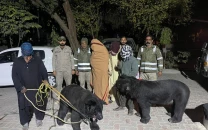World Thalassaemia Day: The bold and the beautiful
Couple sets new standards by taking thalassaemia test, donating wedding outfits and refusing dowry.

Khushboo and Usman on their wedding. PHOTO: COURTESY KHUSHBOO
As the guests in other marriage halls in North Nazimabad anxiously awaited the arrival of baraats at 10:15 pm on February 22, the ones at Khushboo and Usman’s wedding were happily returning home after the wedding dinner. Punctuality, however, was not the only surprise the couple had planned. The wedding invite was different too, as it carried five special announcements.
“Please do not bring gifts,” read the first condition. “If you bring a gift, it will cause trouble to us and, when you take it back, it will cause trouble to you.” The second was “No dowry”. The couple will be starting a tradition by donating their wedding attires at the end of the ceremony, read the fourth condition. And the fifth and last one was that the couple requested everyone to follow their example.
In a country where an estimated 100,000 people suffer from thalassaemia, perhaps the most important announcement was the third one: the couple had undergone a thalassaemia test before the big day.
Khushboo and Usman got themselves examined from two different places, namely Fatimid Foundation and Aga Khan University Hospital, as they believed this to be a much more sensible investment than throwing away money on ostentatious wedding rituals.
“All decisions were taken by the mutual consent of both families,” said the groom, Usman. When asked about the feedback on the conditions set by the families, the bride’s mother Zakia Sultana said it was not easy. “But change is never easy. An example has been set. We are trying to encourage others who are afraid of taking such steps.”
According to Omair Sana Foundation’s Nazirul Hasan, 80,000 to 100,000 Pakistanis suffer from thalassaemia and around 5,000 to 6,000 babies are born with this disease in Pakistan every year. “Since there is no data registry centre,” he said, “there is no proper record of the number of patients.”
Conducting tests before getting married is the only thing that can prevent it, said Nazir. “This disease is enough to completely disturb a family.” He added that if parents carry thalassaemia minor, there is 25 per cent chance that the child will have thalassaemia major.
A thalassaemia patient needs frequent blood transfusions, costing around Rs10,000 every month, he said. The average age of the patients, according to Nazir, is between 15 and 20 years; in some cases they manage to reach the age of 35 to 40 years. “Bone marrow transplant costs around Rs2,500,000 to Rs3,000,000,” he added.
“A thalassaemia test costs you Rs5 only,” said the project director at Hussaini Blood Bank, Dr Sarfaraz Husain. “All we need is a syringe, a test tube, salt and a glass of water,” he said, adding that only 20 out of 100 people are needed to be examined again if the results are not clear in the first test. At the second stage, doctors conduct the Complete Blood Count (CBC) test which costs Rs100. If needed, a haemoglobin electrophoresis test is conducted which costs Rs600. “Only one per cent people need the third test,” said Husain, adding that people are becoming more and more aware about thalassaemia as young couples have started to turn in for thalassaemia tests prior to marriage and considering having a child. Prenatal diagnosis, thus, is something for which awareness is needed. Usman and Khushboo have set a great example in this regard.
Commenting on the thalassaemia test, Khushboo felt that it was very important. “It is far more important than the ritual of joota chupai.” Many people criticised the invite, shared Khushboo. “Hat kay kuch karna hai tou apko mazboot hona paray ga [If you want to do something different, you must be strong].”
The main reason behind turning the invite into a list of do’s and dont’s was to create awareness, said the 25-year-old bride. “My cousin’s wedding cost around Rs900,000 and we spent somewhere between Rs150,000 and Rs200,000 on mine.” She purchased artificial jewellery and was taking a suitcase full of simple clothes, shoes and some books with her. “That’s all,” she shared.
Despite the request, a few people showed up with gifts that the couple decided to donate to an NGO, Kumak Pakistan, said the bride’s mother. “Bridal dresses are worn only once and, that too, for a few hours, but if we start recycling the clothes, it would be beneficial for many,” said Khushboo. By donating their clothes, they hope to make someone else’s day special. The couple said that they have made a Facebook page to rent out the clothes. Many people have already joined it and donated their clothes.
The conditions did not, however, change the festive mood of the guests and the party was held with much enthusiasm. “Raat yun dil mein teri khoyi hui yaad aai jaise veerane mein chupke se bahar aa jaaye,” sang the groom.
Published in The Express Tribune, May 8th, 2014.



















COMMENTS
Comments are moderated and generally will be posted if they are on-topic and not abusive.
For more information, please see our Comments FAQ